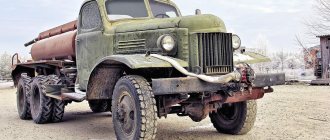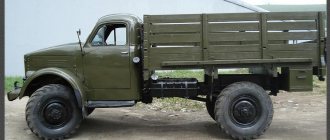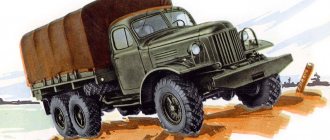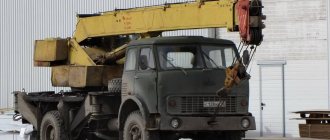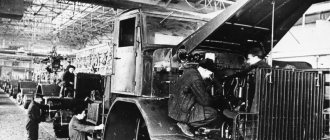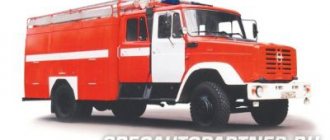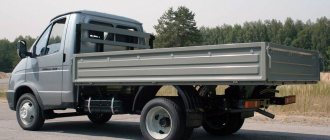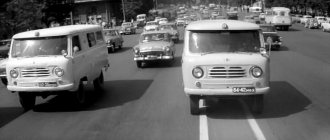1947 In the USSR, the restoration of the “national economy”, destroyed during the war with Germany, is proceeding at an accelerated pace. To help the country, the automobile plant named after. Stalin begins production of the ZiS-150 serial truck, which replaced the legendary ZiS-5, popularly called “Zakhar Ivanovich” on the assembly line. By the way, the love of the chauffeur fraternity to rename cars in their own way did not bypass the new car, which received the nickname “one hundred and fifty.”
ZiS-150: history of creation - beginning
The history of “one hundred and fifty” began back in 1937, when, under the leadership of E.I. Vazhinsky came up with a project for the ZiS-15 car - a new truck, which was already planned to replace the aging ZiS-5.
The ZiS-15 was much more powerful than its predecessor. The vehicle's carrying capacity was 5 tons, the cabin became three-seater and acquired more advanced, for its time, streamlined shapes. But by 1939, already without Vazhinsky, who was repressed in 1938, the car received a number of improvements. In the new version, the gearbox has become five-speed, the load capacity has been reduced by 1 ton, and changes have been made to the appearance of the vehicle. In this form, in 1940, the truck was presented at the exhibition of national economy (later renamed VDNKh) in Moscow, after which the car began to be prepared for mass production. Moreover, the ZiS-15 was supposed to become the base model for a number of vehicles: the three-ton ZiS-23, the ZiS-24 SUV, two gas generators - the ZiS-25 and ZiS-28, the ZiS-26 truck tractor, as well as a bus with a ZiS-wagon layout 17. But the plans were not destined to come true - 1941 came, and with it the war. Work on the new car has stopped.
FROM AMO TO ZISU
If car production in Russia was difficult to establish, many Russian carriage factories could boast of magnificent automobile bodies. In those years, a wealthy motorist often bought only a car chassis, for which he ordered different carosseries (as they called bodies back then): closed winter (limousine, landaulet), open (tonne, double-chaise, torpedo) or sports.
The technological functionality of the front end of early production buses gave way to aesthetics in different models
Among the famous throughout Russia in 1901–1911. body companies, it should be noted first of all the St. Petersburg “Ivan Breitigam”, “Frese and Co”, “Pobeda”, “P.D. Yakovlev", "K. Krummel", Moscow "P.P. Ilyin", "The Krylov Brothers", "S.I. Subbotin", "A. Evseev”... and this is not the entire list.
The need to create spatially refined shapes and finishes, beauty of design and durability of carriages and carriages led over the course of decades to the emergence of the special profession of coachbuilder.
After the revolution, in preparation for the production of the AMO F-15 truck, a difficult task was faced: to transfer the experience of specialists who had previously worked on the bodies of luxury carriages to simpler ones, but adapted to the large-scale manufacturing method, bus bodies, cabins, tails and platforms.
In any case, it was necessary to use the knowledge and practical experience of coachbuilders and coachbuilders and at the same time create the profession of an automobile body designer specific to automobile production.
How did this happen at the AMO plant? Body engineers who had practical experience in this field before joining the plant were immediately sent to the body department. This is exactly how Ivan Fedorovich German (in 1922), Alexey Alekseevich Evseev (in 1926), Leonid Nikolaevich Gusev (in 1931) and Valentin Nikolaevich Rostkov (in 1936) began their activities.
Ivan Fedorovich German, who headed the body department of the plant in 1922, was a specialist with an artistic and technical education. He gained experience in the design and production of bodies at the 2nd State Automobile Repair Plant in the city of Rodniki, near Ivanovo-Voznesensk. I.F. Herman became the first body designer of the AMO plant. Among his developments are the AMO F-15, ZIS-8 and ZIS-16 buses, the ZIS-5V truck, the ZIS-101 limousine, etc.
In 1926, I. German was replaced by Alexey Alekseevich Evseev, a hereditary carriage maker, whose father owned a carriage factory in Moscow. He came to the enterprise, which by this time had become the 1st State Automobile Plant, from the post of head of the body shop of the Moscow Armored Vehicle Plant, and immediately began developing body production. In 1933 he was awarded the Order of Lenin. And in 1938 A.A. Evseev was arrested. However, a little more than a year later, the engineer was rehabilitated and appointed head of the body shop at the automobile plant named after the Communist International of Youth (“KIM”). He returned to the ZIS only in 1941.
In August 1937, the body workers were transferred to the design department (former technical bureau). By this time, the factory bodybuilders had developed and put into production the bodies of the ZIS-8 and ZIS-16 buses, the comfortable ZIS-101 limousine and a number of other products. The authors of these developments were: B.N. Orlov (at the plant since 1930), N.I. Frantsev (since 1922), L.N. Gusev (since 1931), V.N. Rostkov (since 1936). By the way, B.N. Orlov was the first in the USSR to defend his thesis on the topic of bodywork in 1937. So already in the pre-war years, artistic design at ZIS was at a fairly high level.
Copying foreign (in particular, American) equipment made it possible to speed up the transition to more advanced technologies. But this also entailed aesthetic imitation
Before being implemented in metal, the creators of the government ZIL-111 (right) had to go through a cycle of flawed iterations
The special importance of bodywork in the creation of car designs was emphasized by the establishment in 1943 of the position of deputy chief designer for bodies. The first to take this post was A.A. Evseev.
Continuation of the story and the first production cars
In 1943, work on the truck continued, but under a new designation - ZiS-150. Moreover, now the International KR-11, an American truck supplied to the Soviet Union under the Lend-Lease state program, was taken as the standard.
Some of the “American” components were simply copied and adjusted to the domestic model. It later turned out that this approach to the matter led to serious design errors that were identified already during the operation of production vehicles. In this regard, the ZiS-150 car soon acquired a reputation as “horror on wheels.”
The fact is that the truck being developed was practically not tested. During the entire time that the car was being prepared for production, the factory workers assembled only three prototypes, and of those, only two passed at least some tests. This can be explained by the fact that in parallel with the “one and a half hundred” work was underway on the ZiS-110 (government limousine), the development of which, for well-known reasons, was a priority for the factory workers.
But, one way or another, the first batch of new trucks left their home plant at the end of October 1947, and six months later the conveyor was already in full operation.
Quantity controversy
How many copies of the DAZ-150 did they manage to build? Unfortunately, there is still no exact answer to this question. In the factory annals you can glean such information.
December 1949 The first batch of DAZ-150 cars was produced. 30 vehicles were sent for trial operation to Kuzbassshakhtstroy. January–March 1951. 50 DAZ-150 trucks were produced. However, according to Evgeniy Prochko, no more than eight prototypes of the DAZ-150 model and its modifications were made (flatbed, truck tractor with semi-trailer and short-wheelbase), and the numbers 30 and 50 vehicles, in his opinion, are very doubtful: “Manually, with a hammer, you can knock out wings and facings only for single copies, and 80 sets or at least 50 is already an industrial batch, requiring an established stamping facility*. But he was not at DAZ, since the plant was in its infancy (and this is the most expensive equipment), and there were not enough personnel. So, most likely, these batches of 50 and 30 vehicles were ordinary Moscow ZIS-150s with Dnepropetrovsk superstructures (cranes or dump trucks). And the most realistic number of DAZ-150s built is 8 copies.” Some of these DAZs then entered long-term operation, and were sometimes seen on the roads twenty years later. According to one piece of evidence, one such car was seen in Crimea already in the 1960s. It is known for certain that in one of the DAZs V.A. Grachev moved with his entire family to Moscow (they even brought a cat with them!) when he was transferred to a ZIS. Moreover, this car then ended up at the car plant and walked around the capital for quite a long time. And why shouldn’t she go? Reliable, strong tail, but inside everything is the same as a regular ZIS-150 - change parts at least every day. But everything has its time, so not a single copy of the DAZ-150 has survived to this day, of course. In today's Dnepropetrovsk, there is practically nothing reminiscent of the cars that were once created here. Only a small stand has been preserved in the factory museum, dedicated to the construction of the car plant and the production of the DAZ-150. A few meager lines, and a truck in one of the photos. And in the factory library, now rare automobile publications from the 1940s are still gathering dust.
The author expresses gratitude to Evgeniy Ignatievich Prochko for his assistance in preparing the material.
*For pilot and small-scale production, from the beginning of the 20th century, presses with cheap plastic-concrete and asphalt-concrete dies capable of producing 100–2000 forgings began to be used. They are still widely used today in small businesses, and in the 1950s more than half of all bus manufacturers used this technology. So the version of eight dozen DAZ-150s is not so fantastic. Confirmation of this can be found in the phrase about the plumage, “not requiring deep drawing.” It seems that the maximalists Dolmatovsky and Grachev initially developed a budget version of medium-duty trucks in conditions of resource shortages! (Y.P.)
ZiS-150: technical characteristics
First of all, it should be noted that while the first prototypes had external originality, an almost complete copy of the “American” - International KR-11 - went into production.
- Cabin capacity is 2 people.
- Dimensions cm – 6.72x2.47x2.18 (length, width, height).
- Wheelbase - 4 meters.
- Track: 1.70 cm – front, 1.74 cm – rear.
- Ground clearance – 26.5 cm.
- Curb weight – 3t 900 kg.
- Total weight – 8t 125 kg.
- The ZiS-120 engine, with a declared power of 90 l/s, is of the carburetor type.
- Engine capacity – 5555 cm3.
- The fuel used is A-66.
- The gearbox is five-speed.
- The maximum speed is 65 km/h.
- Gasoline tank volume – 150 l.
- Fuel consumption – 29 l/100 km.
- Turning radius – 16 m.
- The brake system is drum.
Despite the fact that the ZiS-150 was widely used in a variety of economic sectors of the country, this did not mean that it was successful. Quite the contrary, and the reason for the popularity was the usual lack of choice. At that time there was simply no alternative to the “150th” in its “weight category”.
Firstborn
On November 7, 1947, the first DAZ-150 “Ukrainets” car, assembled from components and parts of ZIS and other factories, passed through the festively decorated streets of Dnepropetrovsk. This was a trial prototype of the model, manufactured, or rather processed, by the experimental workshop. It was converted from a prototype ZIS-150 No. 2, delivered from Moscow. This prototype of the capital's "150" had an unreliable transmission and chassis, as well as an outdated design that copied the American International KR11. DAZ body designers B.T. Komarevsky and S.S. Kiselev, with the help of their colleagues who remained in Gorky, completely changed the tail of the car, making it more modern, rigid and technologically advanced. The DAZ-150 had an alligator-type hood (unlike the side access to the engine on the ZIS-150) and an original radiator lining, which smoothly turned into L-shaped wings in the lower part. The wings had a smaller profile (gift space) and a larger gap from the tire to the fender, which was dictated by operating conditions on the black earth country roads of Ukraine in rainy times. The sides of the hood were made easily removable to facilitate access to the engine. In these technological features, its cabin was identical to the GAZ-51 and the future Ural-375, ZIL-131, GAZ-3307.
A promising feature of the exterior was the headlights and sidelights completely recessed into the front plane of the wings (the latter are more familiar to us as the sidelights of the Pobeda GAZ-M20 passenger car). A detail that was just beginning to appear on passenger cars, not to mention more conservative trucks. Here is what the famous constructor and designer Yu. A. Dolmatovsky wrote about this in 1949: “Soviet designers are doing a lot of work to improve the appearance of trucks. The design of the truck should emphasize its power with comparative structural simplicity and reliability. This trend was most clearly embodied in the prototypes of the UlZISNAMI-253 and DAZ-150 cars.” In a word, for those years the appearance of the DAZ was perceived as innovative, and at the same time, oddly enough, cheaper to produce. The calculations showed that with mass production, the costs of manufacturing the tail (consisting of elements that did not require deep drawing) would be noticeably reduced compared to the tail of the standard ZIS-150. Moreover, the entire layout of the machine was also revised. The DAZ cab was moved 200 mm forward and raised 50–60 mm upward, which significantly improved visibility from the driver’s seat. The same procedure made it possible to lengthen the platform by 405 mm (of which by 180 mm due to the rear overhang) while maintaining the base of 4000 mm, which was important when transporting agricultural products that prevailed in Ukraine. At the same time, the plant considered it expedient to shorten the base of the machine to 3800 mm while maintaining the old dimensions of the platform. This was caused by serious concerns about the reliability of the very long driveshaft of the ZIS-150 (2026 mm between the joints). Soon, unfortunately, this was fully confirmed in practice on capital machines and forced the use of an intermediate shaft support in 1954. In addition, a shortened wheelbase improved the maneuverability of the vehicle, increased the safety factor of the frame, reduced the weight and cost of the vehicle, and would make it possible to quickly and easily launch the production of truck tractors and dump trucks. NAMI came to the same conclusions: With a base of 3800 mm, the length of the propeller shaft (even without propulsion support) would be reduced to 1826 mm, and the critical speed would increase to an unattainable 3300 rpm on the ZIS-150. However, this violated the unification with the Moscow truck, and the ministry really didn’t want the latter, so what decision would have prevailed in the end is anyone’s guess. But even on the first sample of the DAZ-150 with a base of 4000 mm, the diameter of the cardan pipe was increased, which made it possible to make 3300 rpm real and safe (though only until the first bending during operation). In addition to the described components, the DAZ-150 was equipped with a stamped front bumper with a mudguard on top (in contrast to the primitive single-beam ZIS-150) and hydraulic shock absorbers for the front suspension (removed from the International KR11), introduced into the design of the Moscow model only in mid-1957 when transition to the modernized ZIL-164. The changes also affected other chassis units. The rear axle beam of the DAZ-150 was made from a stamped-welded pipe of the “Clark” type, in contrast to the cast from malleable cast iron on the ZIS-150, which significantly reduced its weight and the complexity of manufacturing. Subsequently, rear axles with a similar beam were introduced only in the mid-1960s on the GAZ-53A and ZIL-130 (and on equipment exported from Dnepropetrovsk). The first sample of the DAZ-150 had the following parameters (in parentheses are the different data of the ZIS-150): load capacity - 4000 kg + 3 people; dry weight - 4150 kg (4090 kg); overall dimensions – 6890x2500x2260 mm (6720x2470x2180 mm); ground clearance under the rear axle – 265 mm; front wheel track – 1735 mm (1700 mm), rear – 1740 mm; smallest turning radius – 7.5 m; dimensions of the onboard platform 3945x2245x590 mm (3540x2250x584 mm); power unit – ZIS-120 90 l. With. at 2600 min–1; maximum speed – 71 km/h (65 km/h); final drive ratio – 7.63:1; tires – 9.00-20; fuel consumption on the highway - 38 l / 100 km; Highway range with a 150-liter fuel tank is 395 km. In January-February 1948, the new truck was presented at the ministry and underwent brief testing at NAMI. They aimed to determine what the improvements made by DAZ had achieved compared to the Moscow ZIS-150. In view of this, traction and speed tests were not carried out. The layout of the DAZ-150 was assessed generally positively. The length of the machine increased by 170, and the height by 80 mm; The load on the rear axle became a little greater, which relieved the load on the front axle somewhat. The steering wheel turned out to be more comfortable, since the tilt angle of the column was reduced from 45 to 35°. True, the cabin turned out to be a little tighter (since the floor level was raised) and the total weight of the car increased by 60 kg. As tests have shown, the introduction of hydraulic shock absorbers did not have much effect, but supposedly increased the durability of the front springs. Oddly enough, the greatest complaints were made to the external design of the front part. The fact is that the more modern and technologically simple tail of the DAZ-150, as it turned out, made access to the engine quite difficult. When servicing or repairing, it was necessary to remove the hood sides and even the wings or get to the engine components from below. The lack of blinds in front of the radiator was also considered a disadvantage, although the Moscow ZIS-150 did not have them either. In addition, the difficulty of insulating the hood in winter was noted. NAMI recommended reducing the number of horizontal cladding beams for ease of manufacture (on the first sample there were 6 of them - 3 in two niches). Although by and large this was a matter of taste, the factory partly took this into account, and in the latest DAZ-150 samples the number of horizontal bars was reduced to 5. The clutch pedal also drew criticism from NAMI. Due to the displacement of the cabin forward, a very tricky design arose, consisting of two halves and forced around the steering column (it simply could not be done any other way). However, there were no complaints about its work, there were no breakdowns, and the fact that it seemed a little complicated to manufacture was, after all, factory problems.
Disposable ZiS
Perhaps what particularly distinguished the ZiS-150 truck was its poor build quality. If during the Second World War, concern for the well-being of the driver and passengers during the development and assembly of cars took a back seat, if not a back seat, and this was understandable and forgivable. But the “one and a half hundred” gathered, although in post-war, but already in peacetime. However, the wooden cabin remained of satisfactory quality for a very short period. Then it dried up. Drafts and wind whistles became the driver's constant companions. There was no heating provided at all. The first heaters were installed on trucks only in 1956.
In addition, the ZiS-150 was equipped with very heavy wheels. It is not clear what this was connected with, however, it added problems to the driver. Replacing a broken “ramp” became a very labor-intensive and difficult task.
And in general, if we compare the new car with the old “Zakhar” (ZiS-5), then the “one and a half hundred” will surpass its predecessor only in terms of power characteristics.
ORIGINS
The origins of the Amov-Zisov-Zilov school of bodybuilders were laid at the time of the development of the first AMO and ZIS cars and buses, despite the fact that all cars from the AMO F-15 to the ZIS-5 were practically copies of foreign cars Fiat and Autocar. Thanks to the acquired skills and accumulated knowledge, the first generation of Soviet automakers was able to pass on the experience of body design to subsequent specialists.
About 35–40 years passed between the creation of the AMO F-15 and ZIL-130 cars. This is a period of time corresponding to the end of the active work of the first generation of bodybuilders and the creative growth of young specialists. For post-war bodybuilders, the times of the 1950s–1960s turned out to be very fruitful: ZIL-130 and ZIL-131 trucks, high-class passenger cars ZIL-111 and ZIL-114, ZIS-127, ZIL-159 buses, original ZIL-118 “Youth” and many other interesting developments.
At this temporary junction, the creative baton was passed on. The first designers and bodybuilders of the capital's plant, Ivan Fedorovich German, Alexey Alekseevich Evseev, Nikolai Iosifovich Frantsev, Boris Nikolaevich Orlov, Valentin Nikolaevich Rostkov, Richard Gantsevich Piskoppel, also worked.
Some of them remained heads of bodywork departments during the design of the ZIL-130 family of vehicles. And the new generation of bodybuilders at this time and for the next 30 years was led by Vitaly Borisovich Pevtsov. The creators of the bodies of the capital's plant were people who not only had design and artistic abilities, taste and intuition, but also had perfect knowledge of engineering disciplines - design, technology, materials science, strength of materials.
A surprise car
The so-called “surprise” was not only unpleasant, but also extremely dangerous. It proved itself already during the operation of production vehicles.
When developing the ZiS-150, the designers replaced the traditional double propeller shaft with a single, but very long one. This innovation led to the fact that while driving at a speed close to 70 km/h (on descents), the “cardan” developed too high a rotation speed, which led to its breakage. But the worst thing was that the torn shaft caused critical damage to the air brake line running next to the “cardan”. As a result, the truck moving at high speed was left without brakes, which sometimes led to real tragedies. The car plant received complaints indicating this defect. Naturally, the plant designers could not ignore these signals; the machine required urgent improvement.
Another design solution
Following the logic, the easiest way out of this situation was to replace the long “universal shaft” with a proven double one. But, for unknown reasons, the developers categorically refused such a replacement, and took a different path, probably, in their opinion, simpler and more rational - they decided to install a speed limiter on the engine, which would not allow the “cardan” to spin up to a critical value. However, this decision was also justified by the fact that now the motor was not subjected to increased loads, which significantly increased its working life.
I waited for the ZiS-150 and its double “gimbal”, but this happened only in 1954. So, three years before the production of the truck ceased, it turned into a more or less reliable and quite tolerable car, on the basis of which a lot of modifications were developed, and even an attempt was made to create a Ukrainian “brother” - the DAZ-150.
"Ukrainian"
All of the above developments were secondary, and the main products of the newly created automobile plant were to be trucks. The DAZ design team, headed by V. A. Grachev, creatively revised the design of the finally selected production facility - the Moscow ZIS-150 - and carried out a deep modernization of it, the result of which was its own version of the vehicle - the 4-ton flatbed vehicle DAZ-150. It must be emphasized that the initiator of the creation of the DAZ-150 was, first of all, Vitaly Andreevich Grachev (as they spoke of him - a maximalist in the good sense of the word) and his colleagues, who back in 1944 were very critical of the ZIS-150 and had behind them a much more successful GAZ-51. They decided on their own initiative to redo the front part of the car, as it was the most unfinished. No approval or consent from the ministry (let alone instructions) was received. Grachev, as had happened more than once, redesigned the car at his own risk, went to Gorky, where, thanks to the help of A. A. Lipgart, working drawings, hood and tail parts were made for a new car, called “Ukrainian”. And only later, when a prototype of the model was already ready, the ministry reluctantly agreed to consider it. Moreover, the attitude towards the car was initially negative: “You never know what they’ll do locally?! There was no order from above, no one allocated funds for modernization.” The instigators were even reprimanded in the press: “...DAZ arbitrarily carried out modernization, which was not approved at the ministry level. Such amateur activities should not take place.” And yet Grachev somehow managed to convince all levels of management and defend his car.
DAZ-150 - brother of the “one and a half hundred”
After the liberation of Dnepropetrovsk from the Nazis in 1944, the State Defense Committee decided to build an automobile plant in the city, where it was planned to organize the production of the GAZ-51. In this regard, the Gorky residents created a design group headed by V.A. Grachev, who was sent to Ukraine. But while the plant was being built, plans changed, and instead of the GAZ-51, the Dnepropetrovsk Automobile Plant (DAZ) was instructed to start producing trucks that were copies of the ZiS-150. However, Grachev, on his own initiative, which he later had to defend before top management, improved the vehicle, almost completely changing the cab and tail of the truck.
Having successfully passed through bureaucratic obstacles, in 1948 DAZ was allowed to produce its modernized truck. In addition, the factory workers on its basis also developed a truck tractor, which received the index - DAZ-150B.
Even before 1951, when the plant was planned to be fully ready for mass production of its vehicles, Gorky residents managed to assemble several pre-production DAZ-150 trucks. But then suddenly the Ministry of the USSR Armed Forces took the automobile plant into its department, with the decision to repurpose it for the production of R-1 missiles. Attempts by the DAZ management to defend production were stopped personally by Stalin.
Thus, the DAZ-150, the Ukrainian “one hundred and fifty”, has sunk into history, and several cars that managed to leave the enterprise before the reorganization were lost in the vast expanses of the country.
In anticipation
By the end of 1948, i.e. exactly 60 years ago, the scales still tipped in favor of the DAZ-150. The car was given the green light at the very top. At the plant, simultaneously with its construction, preparations were underway for the production of a 4-ton (chassis index - DAZ-120). For the first time in the USSR, the Clark production line for the production of stamped rear axle beams was installed, and the second specialized production of wheel rims was created after GAZ (then the only one in the whole country). At first, the power units were supposed to be received from Moscow, and subsequently produced at DAZ together with the gearbox (the technology was compiled). In addition to all this, developments continued in other areas.
In 1948, the plant produced 504 K-31 truck cranes and produced 55 FM-300 molding machines. We designed and built prototypes of 3- and 5-ton hydraulic forklifts of the “4000” and “4001” models, which were subsequently put into production in Lvov. For the first time, the plant fulfilled and exceeded its annual plan for gross and marketable output. The department of the chief designer has completed and submitted to the minister for approval the technical design of the floating car DAZ-485.
At the end of 1948, in parallel with work on the DAZ-150 family, the DAZ design department, commissioned by the Ministry of Armament, took on a major interesting job - designing an amphibious vehicle similar to the American three-axle GMC-DUKW-353. The floating all-terrain vehicle DAZ-485 was developed in an extremely short time based on the enormous enthusiasm of the creators: Ë. A. Berlin (lead designer), S. I. Tyazhelnikova (engine), A. X. Lefarova (transmission), B. T. Komarevsky and S. S. Kiselev (body), Yu. S. Paleev (road tests) and others. On this machine, for the first time in the practice of the domestic automotive industry, single-slope cylinders of large cross-section were used with internal air pressure adjustable on the go. The car turned out to be durable, mobile, easy to drive, had a smooth ride and, most importantly, exceptional, unprecedented cross-country ability, for which it had practically no equal at that time. Its performance on the water was also excellent.
In April 1949, the 1000th K-31 truck crane was produced, and already in June the plant switched to serial production of K-32 truck cranes on the three-ton ZIS-150 chassis. From July to September, trial tests of the first two floating DAZ-485 vehicles were carried out on the Dnieper.
Work continued on the DAZ-150. Along with the refinement of the basic model, modifications were also created. By order of the ministry, by the summer of 1949, the DAZ-150B truck tractor was built to work with the 7-ton semi-trailer “5100” (1-PP-7), created at the plant on the basis of the 6.4-ton Edwards semi-trailer supplied under Lend-Lease D11V. Compared to an onboard vehicle, the base of the DAZ-150Á was shortened to 3800 mm; the dimensions also changed accordingly (6670x2400x2260 mm). A fifth wheel coupling device was installed on the car, the design of which was also not original, but was a metered copy of slightly altered dimensions, borrowed from the American Lend-Lease model. The final drive ratio on the DAZ-150Á was increased to 9.28:1; a control valve for air brakes of the YaAZ-200 type was introduced (to activate the semi-trailer brakes), and the spare wheel was moved behind the cab. The total weight of the road train was 13.3 tons. Along with the cargo semi-trailer, an army version “5100” was also created to accommodate the “Grom” mobile radar complex. In 1949, trial operation of the DAZ-150 of various modifications began.
In October, the chief designer’s department completed the design of the DAZ-150 “Ukrainets” truck. During 1949, four prototypes of the DAZ-150 car of various modifications were manufactured. Factory tests have been carried out. Testing of prototype vehicles has begun at NAMI.
Some publications say that a long-wheelbase version of the vehicle, the DAZ-150V, was also built. Is it so? Alas, there is still no clarity on this issue. One of the oldest Russian automobile historians, E.I. Prochko, who was the first to mention this modification in his 1977 material, later wrote that he actually did not remember such a variety, and perhaps he was mistaken then. According to surviving reports, the long-wheelbase modification of the DAZ-150 is not visible; there is no documentary evidence of its construction. And there was no need for it at that time - long-wheelbase vehicles are not needed on rural off-road conditions. But short-wheelbase versions, on the contrary, were prepared not only for road trains, but also for dump trucks on the DAZ-150 chassis.
Throughout 1949, the production of the driveshaft and steering gear was mastered. 1,650 K-31 and K-32 truck cranes, 98,394 wheels for ZIS-150, 5,046 wheels for K-31 truck cranes were produced. The annual plan for the production of commercial products has been fulfilled by 130%. In December, the Council of Ministers of the USSR instructed the plant to organize serial production of ZIS-585 dump trucks from September 1950.
The next year, 1950, also became fruitful for the plant. From September to October, factory and interdepartmental tests of the DAZ-485 amphibian were carried out in the Crimea and the Caucasus. The tests were attended by chief designer V. A. Grachev, head of the road test laboratory Yu. S. Paleev, leading designer E. A. Berlin, test driver P. A. Mizinov and others. After successful completion of the tests, two samples of the amphibian were handed over to the customer - The USSR Ministry of Defense, where the vehicles were assigned the army index BAV - heavy-duty waterfowl vehicle.
On September 1, 1950, serial production of ZIS-585 dump trucks began in cooperation with the Moscow and Kutaisi automobile plants. By the end of the year, 623 dump trucks were produced. In 1950, 2,034 K-32 truck cranes, 184,512 automobile wheels for the ZIS-150, 11,692 tractor wheels were produced, and 38 types of auto parts were produced.
By the beginning of 1951, the plant had already built and put into operation a press building with a total area of 40,000 m2 with two lines of presses, a malleable cast iron foundry, a large experimental workshop, and a rear axle workshop; spring, wheel, reinforcement shops; A gray cast iron foundry was built. As of January 1, 1951, the payroll of the automobile plant was 8,768 people, of which 6,123 were workers, 1,172 were engineers.
On March 19, 1951, a meeting was held at the plant regarding the awarding of the title “Stalin Prize Laureate” to plant director (since 1950) G. M. Grigoriev, chief designer V. A. Grachev, head of the body bureau A. T. Komarevsky and turner -innovator I. E. Thor for the development and production of the floating car DAZ-485.
After state tests, the DAZ-150 Ukrainian truck and the DAZ-485 amphibious vehicle were recommended for mass production. There were only a few days left before the launch of the first stage of DAZ, but in the spring of 1951 the military managed to take away the practically built giant from motorists and, surrounding it with a high fence and rows of barbed wire, turned it into an invisible plant.
Modifications of the ZiS "one and a half hundred"
The first modification of the truck was the two-axle, all-wheel drive SUV ZiS-150P, but this vehicle was experimental and never reached serial production.
The next modification was a car labeled ZiS-151 - it was a three-axle all-wheel drive model, a domestic Studebaker, inferior to the famous “American” only in dynamic characteristics. Later, the very successful ZiS-152 armored personnel carrier was built on its basis.
ZiS-150 - the dump truck was produced by the Mytishchi Mechanical Plant, only it came off the assembly line with the marking ZiS-585. In addition, ZIS experimented by producing vehicles with different carrying capacities, running on liquefied gas and diesel fuel, as well as half-track vehicles. The ZiS-150 base was also used to build special vehicles.
ZiS special vehicles
The most popular type of special vehicles were tanks, primarily intended for transporting fuel. ZiS, trying to satisfy consumer demand, produced two types of tank trucks, based on the 150th - ATs-4-150 and ATsM-4-150 (refueling truck). A container with a volume of 4 cubic meters was installed on the chassis of the car. m, for transportation of fuel, with the possibility of its temporary storage. Also, the ZiS-150 chassis was widely used for the installation of various types of cranes - both loading and construction.
To combat fires, the Moscow Automobile Plant produced a specialized ZiS-150 - a firefighter.
The new truck has also found its place in geological exploration. Drilling rigs were mounted on its chassis, the drive of which was powered directly from the 150th engine. The ZiS-150 could also be found as a snow removal vehicle, sewer truck, or garbage truck.
Despite the dubious quality of the truck’s design, it also attracted interest outside the Soviet Union.
Sources
Cars ZIS-101 • ZIS-101S • ZIS-101A • ZIS-101E • ZIS-101L • ZIS-101L-1 • ZIS-102 • ZIS-102A • ZIS-110 • ZIS-1105 • ZIS-110A • ZIS-110B • ZIS-110V • ZIS-110P • ZIS-110Sh • ZIS-115 Buses ZIS-MKIM •ZIS-6 “Lux” • ZIS-8 • ZIS-16 • ZIS-16S • ZIS-154 • ZIS-155 • ZIS-127 Sports cars ZIS-101A-Sport • ZIS-112 • ZIL-112S Experienced cars ZIS-E134 Military equipment ZIS-34 • ZIS-43 • ZIS-22MB • ZIS-485 • ZIS-152 Fire trucks based on ZIS ARP-2 (on the ZIS-150 ) • PMZ-1 (on the ZIS-11 chassis) • PMZ-1 (on the ZIS-5 chassis) • PMZ-2 (on the ZIS-6 chassis) • PMZ-3 (on the ZIS-6 chassis) ZIS-5) • PMZ-5 (on the ZIS-5 chassis) • PMZ-6 (on the ZIS-11 chassis) • PMZ-7 (on the ZIS-5 chassis) • PMZ-8 (on the ZIS-5 chassis) • PMZ -9 (on the ZIS-150 ) • PMZ-10 (on the ZIS-150 ) • PMZ-10M (on the ZIS-150 ) • PMZ-11 (on the ZIS-5 chassis) • PMZM-1 (on the ZIS chassis -150P) • PMZM-2 (on the ZIS-150P chassis) • PMZM-3 (on the ZIS-150P chassis) Airfield equipment based on ZIS VMZ-34/VMZ ZiS-6 * - development of LTA based on the ZIS chassis
Imported 150s
In addition to the fact that the USSR supplied domestically produced ZiS-150 to the countries of the “socialist camp” and the Middle East, Hungary, Romania and China mastered the independent production of trucks. Production lines in these countries were built according to Soviet technical documentation, and using domestic equipment, however, the machines rolled off the assembly lines under their own names. In China, the ZiS received real recognition, to the point that the image of the first models of the truck was placed on one of the banknotes of the People's Republic of China.
But in the Soviet Union, letters continued to arrive at the plant with indignation about this truck. In the end, on October 7, 1957, production of the ZiS-150 in the USSR was completely discontinued, and was replaced by the modernized ZiS-164.
POST-WAR RENEWAL
By the end of the Great Patriotic War and immediately after it, the ZIS-150 trucks, as well as the ZIS-154 city bus, were created. Their designs turned out to be far from the most successful in the history of the plant. The number of defects in trucks was unimaginably high, including those that led to fatal accidents. For example, a break in the driveshaft of a ZIS-150 at maximum speed. And there were many body defects. Their reason lay in the extremely small capacity of the design department and the lack of experience in creating designs for new full-size cars. In addition, the plant undertook to create designs for four new cars in less than 6 years. Unprecedented!
Design of the front end of serial trucks ZIS-150, ZIL-164, ZIS-151 and ZIL-157
The overwhelming majority of defects were discovered not during testing of prototypes, but during the operation of produced vehicles. And this is no coincidence - before the start of production of the ZIS-150 in 1948, only three prototypes were made, one of which was soon transferred to the Dnepropetrovsk Automobile Plant. In 1946, for the creation of the ZIS-110 car, the chief designer A.N. was awarded the Stalin Prize. Ostrovtsev, engine operator A.P. Siegel, bodybuilder L.N. Gusev and chief designer of the ZIS B.M. Fitterman.
In 1953, 62-year-old A.A. Evseev was replaced by the energetic and purposeful 43-year-old Richard Gantsevich Piskoppel. A graduate of the Moscow Aviation Institute, before joining the company he worked in the quality control department of plant No. 33. However, at ZIS he became a body design engineer. And soon, in 1954, native Zisovites were placed at the helm of the factory. Alexey Georgievich Krylov was appointed director, and Konstantin Vasilyevich Stroganov - chief engineer. As the further course of events showed, this tandem, like no other, either before or after them, could so support and understand the plant designers. In the same year, native Gazovan Anatoly Mavrikievich Krieger was appointed chief designer of the ZIS, who later became well accustomed to the Zilov “standard.” This trio was destined to lead the plant out of the crisis of the war and post-war years.
At the new and most successful stage in the history of the plant, the first domestic intercity bus ZIS-127 appeared. At first, he became a record holder in transportation. With two drivers working in shifts, a bus with passengers covered 1,400 kilometers from Moscow to Simferopol in 19 hours. In 1966, for the plant’s half-century anniversary, a crew arrived from Simferopol on a ZIS-127 with a total mileage of 1 million 800 thousand kilometers! Its body was still strong, did not creak anywhere and had never been overhauled. And six engines were replaced on it.
In 1957, it was the turn of the ZIL-158* city bus, produced for the World Youth Festival in Moscow. As they say, it did not receive any applause and was clearly inferior in body to the handsome ZIS-127. By this time, the plant had developed city buses ZIS-129, ZIL-159 and ZIL-129B, but in 1960 the production of buses was transferred to Likino-Dulyovo near Moscow.
* Note. The ZIS plant was renamed ZIL only in 1956, so the first two copies of the new buses were called ZIS-158.
The avant-garde design of ZIL city, suburban and tourist buses in the late 1950s reflected global trends of those years
